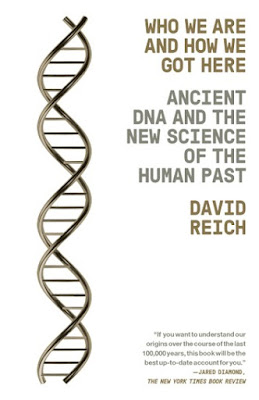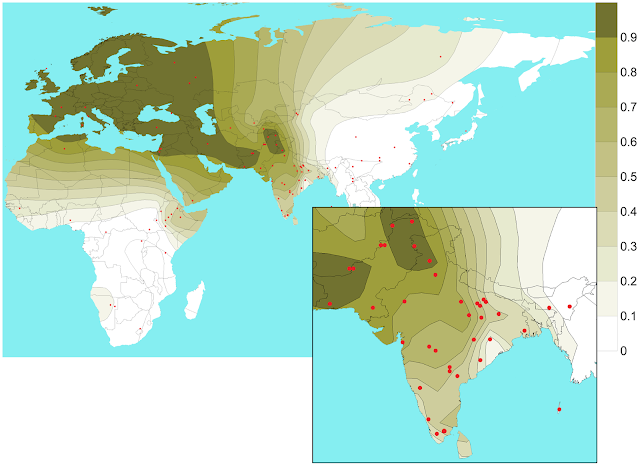PakAlumni Worldwide: The Global Social Network
Male ancestors of the vast majority of present-day South Asians (Indians, Pakistanis, Bangladeshis) came from West Eurasia, Central Asia and Iran, according to the latest DNA research led by Harvard geneticist Dr. David Reich. Reich's team came to this conclusion after studying the Y-chromosomes of present-day Indians. Some Hindu Indian scientists have used mitochondrial DNA (mtDNA) samples, extracted from the bones of recently discovered ancient skeletal remains of a couple in Rakigarhi in Haryana, to claim the local indigenous origins of all Hindus. Y-chromosomes are passed from father to son while mitochondrial DNA is passed from mother to children. The Harvard team's findings thoroughly debunk Hindu Nationalists' "racial purity" myth similar to that promoted by White Supremacist racists in the West. Reich writes: "The Hindutva ideology that there was no major contribution to Indian culture from migrants from outside South Asia is undermined by the fact that approximately half of the ancestry of Indians today is derived from multiple waves of mass migration from Iran and the Eurasian steppe within the last five thousand years".
 |
| David Reich's "Who We Are" |
Reich's Indian counterparts were highly resistant to the Harvard team findings of foreign origins of modern-day South Asians. Here's an excerpt from David Reich's "Who We Are and How We Got Here":
"Based on their own mitochondrial DNA studies, it was clear to them (Indians) that the great majority of mitochondrial DNA lineages present in India today had resided in the subcontinent for many tens of thousands of years.They did not want to be part of a study that suggested a major West Eurasian incursion into India without being absolutely certain as to how the whole-genome data could be reconciled with their mitochondrial DNA findings. They also implied that the suggestion of a migration from West Eurasia would be politically explosive. They did not explicitly say this, but it had obvious overtones of the idea that migration from outside India had a transformative effect on the (South Asian) subcontinent".
"To keep up the purity of the Race and its culture, Germany shocked the world by her purging the country of the Semitic races -- the Jews. Race pride at its highest has been manifested here. Germany has also shown how well-nigh impossible it is for races and cultures, having differences going to the root, to be assimilated into one united whole, a good lesson for us in Hindusthan to learn and profit by."
"Groups of traditionally higher social status in the Indian caste system typically have a higher proportion of ANI ancestry than those of traditionally lower social status, even within the same state of India where everyone speaks the same language. For example, Brahmins, the priestly caste, tend to have more ANI ancestry than the groups they live among, even those speaking the same language. Although there are groups in India that are exceptions to these patterns, including well-documented cases where whole groups have shifted social status, the findings are statistically clear, and suggest that the ANI-ASI mixture in ancient India occurred in the context of social stratification".
 |
| South Asian Ancestry. Source: Arain Gang |
 |
| 1901 Indian Census of UP Muslims |
 |
| Light Skin Gene Distribution. Source: PLOS Genetics |
 |
| 1901 India Census UP Hindu Population By Castes |
World Values Survey Finds Indians Most Racist
Indians Admire Israel and Hitler
Caste Apartheid in India
Religion, Caste and Politics in India by Christophe Jaffrelot
Mahatma Gandhi and His Struggle With India
Who Killed Karkare?
Procrastinating on Hindutva Terror
India's Guantanamos and Abu Ghraibs
Hindutva Government in Israeli Exile?
Growing US-India Military Ties Worry Pakistan
The 21st Century Challenges For Resurgent India
Riaz Haq
Study links endogamy to persistence of harmful genetic variants in India
https://www.thehindu.com/sci-tech/science/south-indian-population-h...
A large-scale medical genetics study aimed to identify unique genetic variants behind South Asia’s health problems.
In 2009, a study in Nature Genetics by the group of Kumarasamy Thangaraj, at the Centre for Cellular and Molecular Biology, Hyderabad, reported a fascinating finding on why a small group of Indians were prone to cardiac failure at relatively young ages. They found that the DNA of such individuals lacked 25 base-pairs in a gene crucial for the rhythmic beating of the heart (scientists call it a 25-base-pair deletion).
Intriguingly, this deletion was unique to the Indian population and, barring a few groups in Southeast Asia, was not found elsewhere. They estimated that this deletion arose around 30,000 years ago, shortly after people began settling in the subcontinent, and affects roughly 4% of the Indian population today.
Jul 15, 2023
Riaz Haq
Why Endogamous Marriages Could Make Us An Unhealthy Population
https://feminisminindia.com/2020/09/11/endogamous-same-caste-marria...
Endogamous marriages are the ones that take place within a particular social group such as caste, clan, tribe, gotra, etc. The presence of thousands of castes and communities in India has led to the formation of a very fragmented and dissociated society.
Posted by Shivani Gual
When I look around my family and close relatives, I often find multiple family relations between two people. My father’s sister married a man whose sister married my mother’s brother. You might need a pen and a paper to figure that one out! What I intend to communicate here is that in small communities marriages among relatives is a common affair. This is known as endogamy.
Endogamous marriages are the ones that take place within a particular social group such as caste, clan, tribe, gotra, etc. The presence of thousands of castes and communities in India has led to the formation of a very fragmented and dissociated society. These castes, even though belonging to the same religion, are so different from each other that it is laborious to find similarities in their customs and traditions. As a result, marriages are found to be conventionally more successful when they are endogamous due to the familiarity between the two cultures.
Also read: Endogamous Love: On Love Jihad & Marriages In India
Endogamous marriages are the ones that take place within a particular social group such as caste, clan, tribe, gotra, etc. The presence of thousands of castes and communities in India has led to the formation of a very fragmented and dissociated society.
One of the most common endogamous groups is caste. Caste-system in India is primordial and it was first mentioned in Rig Veda, the oldest Hindu shastra. This division that varna-system created has lost its muscle today but the notion and attitudes remain in the minds of people. Every caste has its sub-castes and an imperceptible hierarchy exists which results in the formation of new endogamous groups. Due to the presence of a strong caste system in India, inter-caste marriages are overtly avoided even today.
The social and cultural gap between different endogamous groups is so significant that marriages among them are believed to destabilise and dismantle the society. Consequently, the choices for marriage unions are limited and restricted to the core primary group. When members of this group mate and have children, it is often found that these children suffer from genetic imperfections that their ancestors might have possessed. Inbreeding is one of the reasons for these ‘hereditary diseases’.
Inbreeding is a phenomenon where two close relatives mate with each other. While there is a huge demand for inbreeding in animals such as dogs and cows for various reasons, it is a taboo in many human societies. Inbreeding is infamous as it results in sub-optimal heritable attributes in the inbred offspring. When a child inherits a pair of recessive genes, one from each parent, it becomes dominant even though it might have been inactive in the parent. The chances of a recessive gene being present in close relatives are higher and therefore it is more likely that an inbred child will have a genetic disease.
In our fragmented society, there are over 4000 castes and communities, some of which comprise only a few hundred people. When a group of people indulges in marriage unions through generations, it results in an aggregated gene pool due to the absence of diversity. This limited gene pool is often responsible for the transmission of recessive genes from one generation to another creating a risk of chromosomal, genetic, or congenital abnormalities.
Jul 15, 2023
Riaz Haq
The Western Steppe Herders and the Formation of South Asian Ancestry
This map visualizes the main ancestral components of South Asian populations as modeled through Genoplot and Global25, highlighting the genetic impact of the Western Steppe Herders (WSH) contribution, the population associated with Bronze Age expansions from the Pontic–Caspian steppe (ca. 3000–1500 BCE).
The WSH component (light blue) represents the genetic legacy of the pastoralist societies connected with the Yamnaya and later Sintashta–Andronovo cultures, whose migrations profoundly reshaped the genetic and linguistic landscape of Eurasia. In South Asia, this ancestry entered the subcontinent around the mid-second millennium BCE, merging with pre-existing Neolithic and indigenous groups.
Its highest frequencies are observed among northern Indo-Aryan populations, notably in Punjab, Haryana, Kashmir, and parts of Uttar Pradesh, correlating closely with the historical diffusion of Indo-European (Indo-Aryan) languages and with Y-chromosome haplogroup R1a-Z93. The genetic signal diminishes gradually toward the Dravidian south and the Austroasiatic east, where AASI and Neolithic Iranian ancestries predominate.
This pattern indicates a north-to-south cline formed through male-biased gene flow, consistent with the arrival of steppe pastoralist groups who intermingled with established farming and hunter-gatherer populations. The interaction between the WSH, Neolithic Iranian, and AASI components produced the distinctive genomic structure of modern South Asians, reflecting a synthesis of steppe, Near Eastern, and indigenous South Asian lineages that continues to define the region’s diversity today.
yesterday